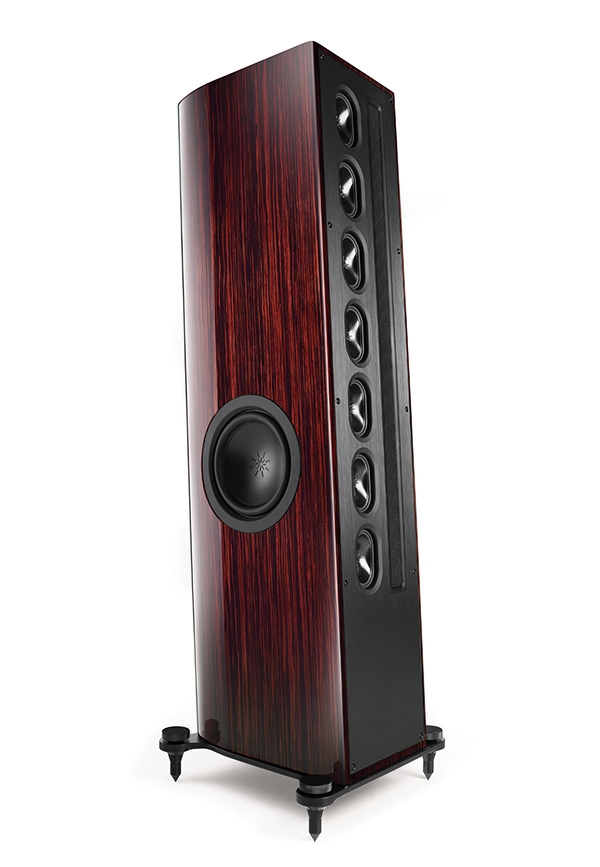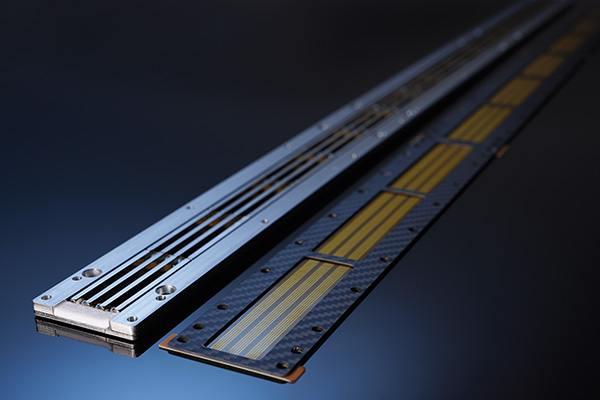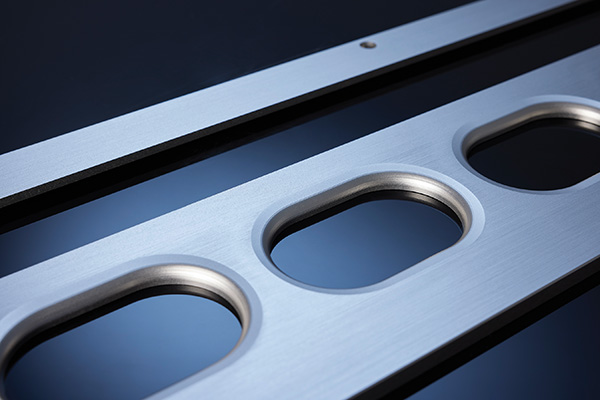| Columns Retired Columns & Blogs |
https://www.stereophile.com/floorloudspeakers/1204bg/index.html

What I didn't know until recently is that T+A makes loudspeakers, and they're quite different from the loudspeakers other companies make. I only learned this when I started hearing about the S 530 and its larger sibling, the S 540, from friends—friends whose ears I trust.
For the last 15 years, I've been listening to relatively conventional, multi-point-source speakers, which emit overlapping, approximately spherical wavefronts from drivers that usually are round. This group includes most recently the excellent Wilson Sasha DAW, which I still own. Before that string of speakers, I'd been a huge proponent of line sources and planar dipoles: Genesis IIs and Magnepans, for example. Most of those loudspeakers had shortcomings—limitations in ultimate dynamics, impact, detail, sometimes bass extension—but I always found something inherently right about the sound, especially the way they recreated space, which more than made up for those shortcomings.
Which leads to the fourth and final reason I wanted to hear these speakers. When my very first audiophile friend—the one I've known the longest—told me about them, he said, "I think you'd really like them. They're a line source." That sealed the deal.

The T+A Solitaire S 530
The design of the Solitaire S 530 is unusual: When was the last time you saw a speaker that uses seven midrange drivers? Or, even weirder, a tweeter that's almost 3' long?
Actually, the S 530 is relatively conventional compared to other line-array loudspeakers; consider The Note from Laufer Teknik, which stands maybe 10' tall and has 50+ tiny drivers (footnote 2). The S 530 is a 4'-tall tower in a conventional-looking cabinet that's deeper than it is wide but impressively stout and, based on a knuckle rap, substantially inert. You start to notice how unusual it is when you look at the front baffle, consisting entirely of a single thick slab of aluminum with drivers recessed into fluidly shaped, tapered recesses. The "Organic" baffle, as T+A calls it, is a waveguide that shapes the dispersion patterns of the individual drivers into "an ideal line source." The quote is from the company website. Apparently a loudspeaker doesn't need to be 10' tall to be a proper line source.

And those drivers! The S 530's front baffle does not hold, as more conventional loudspeakers do, a vertical array of round drivers in different sizes. On the left are seven ovals. On the right is one extended ... what exactly?
The electrostatic tweeter was one of the first technologies developed by Siegfried Amft when he started T+A in 1978, and they've been a part of the company's DNA ever since. So, I was surprised to learn that the tall thing on the baffle of the S 530 isn't an electrostatic tweeter but a 33.5" long, 1.65" wide magnetostatic, or planar magnetic, tweeter. It was developed in-house by T+A's R&D department, which, the company says, employs 15 engineers. Specifically, the tweeter consists of a Kapton membrane less than 10µm thick onto which a complex array of aluminum patterns has been spray-deposited (footnote 3). Five parallel aluminum traces run down the center of the membrane, connected in series to form a single conductor more than 10m long. The outer portions of the membrane, which aren't part of the center conductor, are covered almost completely with aluminum in a pattern of closely spaced hexagons, intended to create a more uniform magnetic field across the membrane. Behind the membrane are four columns of 64 "Toblerone-shaped" magnets, their narrow ends pointed toward the membrane, located midway between the traces. The result, T+A says, is a magnetic field that changes to oppose curvature in the membrane surface as it deflects, keeping its movements constant over its surface. The result of all this is, to repeat, a tweeter that's almost 3' long.
The change from electrostatic to magnetostatic, I learned, was driven by the former's susceptibility to arcing in warm, humid climates. The technology behind the new driver grew out of the development of the TPM 3100 headphone transducer, a project that was itself a spinoff of earlier loudspeaker R&D.

So, what about the seven ovals on the other side of the front baffle? Those are midrange drivers. It's the first time T+A has used oval drivers—with aluminum cones instead of their usual fiber/carbon mix. The oval shape produces a tall, narrow dispersion pattern that more effectively combines to form the S 530's line array, and for a given surface area, allows their acoustical centers to be closer to the elongated tweeter's.
What about the bass? The bass units are on the side in the form of a new, round, 8.75"-diameter aluminum-cone woofer, which replaces the 8.25" and 8.75" fiber/carbon ones that T+A used previously. The two woofers are side-firing and mounted midway up the cabinet. They are now in a ported (bass-reflex) chamber and in-phase, whereas in earlier T+A models, the chamber was sealed and the drivers in each pair operated out of phase. The point of all this is to create a loudspeaker that energizes a room in a fundamentally different way than conventional speakers.
Conventional round-driver speakers generate a soundwave with a (very roughly) spherical wavefront; think of each driver as at the center of an expanding sphere of sound, at least in the forward direction. What reaches the ear in such speakers is an overlapping combination of spherical wavefronts, each radiating from a different center.
In contrast, a line source is best envisioned—this is the idealized abstraction—as sound emanating from an infinitely long vertical line. It's clear from symmetry (if you think about it) that at least toward the middle of that vertical line, sound can only propagate outward, not up or down. The consequence is that the sound emitted propagates out like a cylinder rather than a sphere.
A real-world line-source loudspeaker isn't infinitely long, so this is all only a rough approximation. What's more, the room has a ceiling and a floor—top and bottom boundaries that constrain the soundwaves. The result is that the sound intensity falls off fast at the top and bottom. The wavefront emerging from a real-world line source is more like a can of Coke (or, very roughly, half a can) than an infinite cylinder. For a speaker like the S 530, you'll want to be sitting down to listen, the speakers aimed accurately at the listening seat. Stand up, and the sonic presentation changes drastically—much more than with a more conventional loudspeaker.
Another big difference between a conventional, point-source loudspeaker and a line-source loudspeaker is how quickly the music's intensity—its volume—drops as you move away from it. With a point source, the wavefront is an expanding sphere, the surface area of which increases as the square of the radius, so the intensity gets smaller as the inverse square of the distance from the source. In contrast, the surface area of a cylinder increases in direct proportion to the radius, so the intensity of sound emerging from a line source speaker gets smaller as 1/r. With a line source speaker, the music volume remains louder farther out into the room. If you're used to conventional designs, this can be a little disconcerting.
This fact also has implications for how the sound interacts with surfaces in the room. There's less interaction with the ceiling and floor, but what about the sidewalls? It's hard to say, because a loudspeaker can call itself a line source while still having a fairly narrow horizontal dispersion pattern; the amount of interaction with the sidewalls depends on the details.

Setup
My listening room is 24' long, so I started out putting the speakers 1/3 of the distance (8') out from the front wall and my listening chair two-thirds of the way (16') out. I started with the Solitaires about 4' from the sidewalls (to the middle of the noncentered tweeter) and my chair in the middle of the room, forming a rough equilateral triangle. The S 530 has three ±1.5dB rocker switches, one each for Bass, Midrange, and Treble; I left these in the "LIN" (flat) position.
After the speakers had been burned in for about a week, I sat down and cued up the first album. The difference from what I was used to was so astonishing that my initial reaction was that something was wrong—not so much that the speakers were broken but that reality was out of kilter. For an instant, my mind flashed to an image burned into my brain at an early age, of furniture and other things suspended in the vortex of a tornado. (Think Wizard of Oz.) The performers were solid, three-dimensional objects suspended in three-dimensional space in a way my brain couldn't quite accept. The next instant, that mental image was gone, the left side of my brain kicked back in, and I started to process what I was hearing. Over the course of a few minutes, I went from thinking something was wrong to recognizing that it wasn't wrong, just different. Not long after that, during a round of moving the speakers to find their optimal positions, I started to think that what the Solitaires were doing wasn't just different—it was right.
Footnote 2: Or had, since they don't seem to be made anymore. You can see photos here.
Footnote 3: See the discussion of this technology in Julie Mullins's review of the Audeze LCD-5 headphone. There's no connection between the two companies except that they're using similar technology.

https://www.stereophile.com/floorloudspeakers/1204bg/index.html